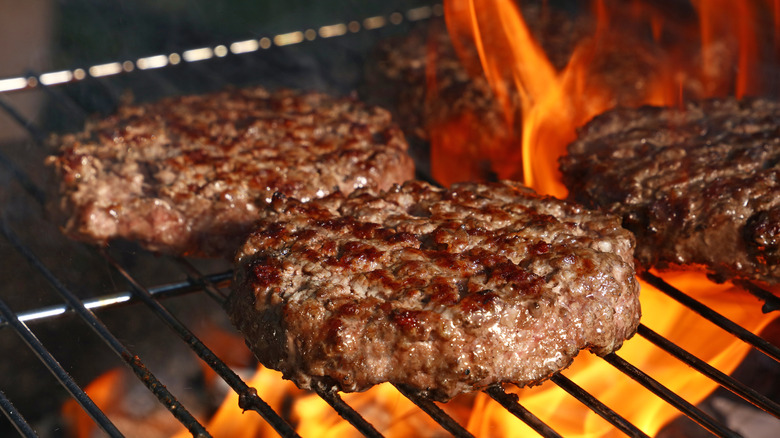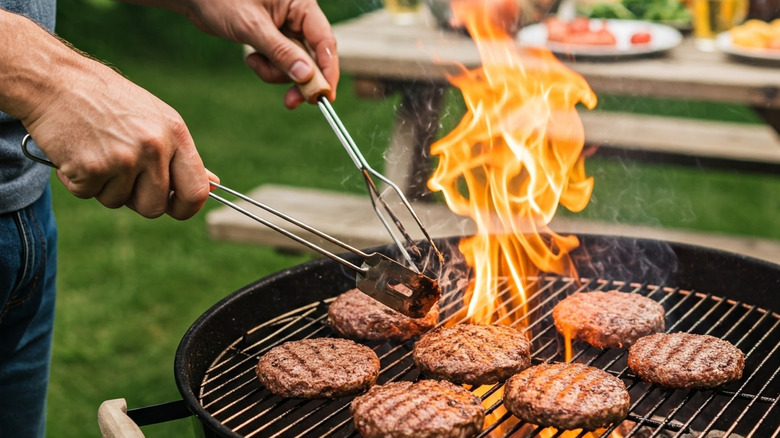Why Cooking From Frozen Might Give You The Best Burger Ever
Many of us have been taught that the only way to cook meat that's been frozen is by thawing it first. However, when it comes to frozen burger patties — a mainstay of freezers everywhere — you might be wondering whether it's okay to cook them from frozen. To gain some answers, Food Republic spoke to Ashley Lonsdale, ButcherBox chef-in-residence, who confirmed, "To many it may come as a surprise, but cooking a beef patty from frozen is a great way to make a burger."
While there are plenty of burger chains that only use fresh, never frozen meat, there are plenty that don't — and for good reason. "When heat is applied to meat, the muscle proteins contract, causing the meat to shrink and expel moisture, which can lead to a loss of juiciness," explained Lonsdale. Similar to how Texas Roadhouse likely cooks its Porterhouse t-bone steak from frozen, cooking a burger this way can create a juicier patty because it helps retain moisture. Lonsdale also pointed out that cooking meat from frozen extends the cooking window, allowing for more time to "achieve a dark brown sear on the outside before the inside heats." The result is a burger patty that has a beautifully delicious charred crust on the outside and a juicy, flavorful inside because you delay the heat from penetrating the center of the meat.
Lonsdale hailed frozen burger patties as a super-convenient meal because they can be cooked in a pan, in the broiler, or on the grill. However, broiling or frying a frozen burger patty often results in grease splatters and lingering cooking smells. Therefore, Lonsdale recommended using a grill because it "allows for high direct heat, which develops a crust and color as quickly as possible."
How to cook a frozen burger patty to get the best results
Even so, if you're going to cook frozen burgers on the grill, it works best to use a flat-top griddle – just keep an eye out for grease splatter to avoid getting burned. A griddle provides a flat, consistent heat source, which allows burgers to retain their moisture and seasonings that would otherwise risk spilling through the grates of a grill. They also provide steady, controllable heat without flare-ups, which helps ensure burgers are cooked evenly, without any raw or charring. If you don't have a flat-top griddle, it's worth investing in a cast-iron skillet or sheet pan that can be placed directly on top of the grill.
Whether you're using a stove or a grill, burgers should reach an internal temperature of 160 degrees Fahrenheit before they're safe to eat, per the USDA. Ashley Lonsdale recommended letting the burger patties sit over the heat for two to three minutes, allowing them to develop a nice sear on both sides. "Once that's formed, feel free to flip often while the patties reach the desired internal temperature," explained Lonsdale. As for timing, Lonsdale said that grass-fed beef patties and other leaner types of ground meat cook faster and therefore require shorter cooking times than patties with a higher fat content. When in doubt, check your patties frequently and use a meat thermometer to gauge doneness.
Lastly, if you're a fan of homemade cheeseburgers, Lonsdale suggested adding the cheese right before you remove the patties from the heat source, placing a lid on top to ensure the cheese fully melts. Lonsdale said, "My personal favorite is a sharp cheddar, or I skip the melting and add cool blue cheese crumbles and raw red onion."


